A. Marchesan, Stockholm: Curated Period Menswear
By Manish Puri
There’s not exactly a shortage of quality secondhand and vintage stores in Stockholm.
Take a stroll along Hornsgatan for example - a busy road running through the Södermalm neighbourhood - and within just a few hundred metres you’ll pass Broadway & Sons, Herr Judit and Ruth & Raoul (to name just a few).
Interestingly, it was explained to me by local friends that Sweden’s higher disposable income coupled with a predilection for “the new” (trends, brands, styles) ensures a healthy supply-line of used goods (clothes and interiors, in particular) into those shops.
And it was one such friend, the ever-stylish Erik (the loveliest of fellas who possesses the irritating ability to go thrifting at a Boy Scouts jumble sale and still come home with an immaculate made-in-Italy, Ralph Lauren DB blazer in his size), who suggested I pay a visit to a vintage place called A. Marchesan whilst I was in town.
What I found, was an extensive selection of vintage tailoring and accessories, crowned by a very wearable range of overcoats. But let's walk through the store together.
The default mise en scène of many of the vintage shops I’ve frequented is a few wall racks groaning under the weight of assorted and unrelated garments. But A. Marchesan was far removed from this; the premises oozed old-world department-store charm and considered curation.
The ground floor houses footwear and accessories. The shoes - displayed on a beautiful wooden, oval-shaped, tiered plinth - were largely Swedish (in the 1930s nearly 250 shoe factories operated in Sweden, employing some 11,000 workers), English and American - with brands like Alden, Allen Edmonds, Church’s, Edward Green, Florsheim, Foster & Son and John Lobb well represented.
The owner, Alexander Marchesan, told me that finding vintage shoes in saleable condition was an increasingly tall order. And so, it’s an endorsement of Simon’s recommendation of Crockett & Jones as a “good-value” shoe that one of the few new products that Alexander carries is a range of brogues and oxfords from C&J.
The dearth of traditional footwear has also presented Alexander with an opportunity to develop his own product, which he was eager to show me. As Yuki Matsuda, founder of artisanal shoe brand Yuketen, put it to Simon recently, “I think a lot of companies start this way - they want to recreate the vintage that they see but can’t buy any more”.
The A. Marchesan Balmoral boot (above) is inspired by a 1920s-1930s style worn in the heyday of Swedish shoemaking. Coincidentally, on my visit I was wearing a pair of Alden parajumpers which helped to bring the design specifics of the more formal Balmoral into sharper focus: an almond-shaped toe and refined waist, a narrower and shorter boot shaft, and more eyelets on the upper.
Made from French goatskin (as this shoe traditionally was) it’s a style that, even a century on, I think has a place in the modern wardrobe - especially in Stockholm where black boots in the winter seem to be de rigueur amongst the locals.
There were other in-house products under development (shirts and knitwear) that I was less taken with, but I’ll be keeping an eye open for the boots when they’re released later this year.
Past the shoes, towards the rear of the ground floor, was a large selection of hats - mostly made by the Italian company Borsalino alongside select vintage finds from Barbisio, Panizza, Preston, Stetson, Battersby, Lock & Co and Mossant.
Alexander joked that “there may be some debate about who made the best hats in the 20th century, but when it comes to the insides of the hats there’s not really a contest” (see above).
Adjacent to the hats was a healthy stock of eyeglasses, socks (also new, also English - sourced from Pantherella’s Vintage collection) and silk accessories: scarves, foulards and ties.
Simon wrote recently about his enduring love of ties and I’ve found that a vintage pick-up is often the perfect opportunity to try a different length/width or an unusual colour/pattern without breaking the bank.
Upstairs on the first floor is where you'll find the tailored offering.
In 1950, Sweden acceded to the General Agreement on Tariffs and Trades (GATT), and the subsequent influx of clothing (from cheaper markets such as Italy) had a similarly detrimental impact on Sweden’s textile industry as it did on shoemaking.
As a result, the majority of tailoring sold by A. Marchesan dates to the late fifties and prior, with an emphasis on Swedish bespoke and quality RTW alongside a smattering of UK and US garments.
I won’t attempt to summarise the vast style of suits and sportcoats - distinguishing between 1920s, 30s, 40s and 50s tailoring would require a whole series of articles authored by a source far more knowledgeable than myself. However the drapey silhouette of several jackets did bring Anderson & Sheppard to mind.
There may even be a link there to Swedish tailor Per Anderson, who founded the Savile Row house in 1906 and helped to develop the Drape Cut it became synonymous with.
I can imagine some PS readers dismissing A. Marchesan as too “period” or “costume-y” for them.
Whilst this is understandable, I think it would be a real shame to miss out on the range of cuts and vintage cloths available. Just take a look at the unusual two-tone stripe of the 1940s Swedish double-breasted suit above. I suspect you’d be hard pressed to find something similar in a modern bunch.
Indeed, the closest I’ve seen is a Fox Brother’s limited edition cloth from their aptly-named Silver Screen collection - which has been expressly designed to “pay homage to the timeless elegance and sartorial excellence of [...] the golden years of Hollywood”.
When browsing the collection of looks on A. Marchesan's Instagram page, I’ve found that mentally expunging some of the period accessories - collar pins, hats and pocket watch chains - can make them a little more accessible and help cast them in a slightly less traditional light.
Above and below are just a few outfits that I think are great as is. I’d also love to hear from readers that have successfully incorporated period tailoring into their wardrobes with any tips on how to do so.
(Above - 1930s Swedish three-piece tuxedo. Below left - 1950s Swedish tweed in a black and violet houndstooth. Below right - 1940s Swedish three-piece suit in Harris Tweed.)
Now, you might remain adamant that vintage suits and jackets made from a heavier cloth, to a fuller length, with a strong lapel and generous silhouette is not for you. And yet, those are precisely the characteristics many of us look for in an overcoat.
It’s here that A. Marchesan really shone for me; their selection of winter coats was as comprehensive as anything I’ve encountered elsewhere - both in terms of quantity (they numbered in the hundreds) and quality.
PS readers often ask where they can find value in classic menswear, and I’d argue that investing in a quality second-hand coat stands head and shoulders above all other options.
Considered purely from a financial perspective, a modest 20% saving on a good coat will be significantly more in pounds and pennies than a 40% saving on, for example, a nice pair of trousers or knitwear.
On top of that, if a coat’s style and cloth has already prevailed over 70-odd years, there’s no reason to believe one won’t be able to squeeze a few more good years from it.
And also, an overcoat is usually far more forgiving to imperfections in fit than a suit or sports jacket.
I could happily have departed A. Marchesan with three or four coats under my arm (not that I would have had the strength to carry that much wool). Indeed, it's most unusual for a shop simply to have that many coats in my UK size of 38-40, let alone in the style and condition here.
After much deliberation, and careful examination of the excess baggage fees of my airline, I purchased a bespoke overcoat (below) made in 1959 by the now-defunct Stockholm tailors Janson & Wallgren, who at the time were holders of a hovleverantör (Royal Warrant).
The coat is fashioned from a deep, dark-navy wool, sourced from the mill of They-Don’t-Make-Em-Like-They-Used-To.
Forgive me, I’m being frivolous here, but it’s incredible how many people have looked at the cloth since (and the way the twill catches the light) and commented on its superiority. A view lent credence by the fact that the coat, apart from a little wear around the neck, appears virtually new.
Even the minor details help set it apart: hand-warmer pockets, a truly sumptuous heavy satin lining finished with piping, and the original coat hook still attached to the collar. (A note to all the High Street retailers that I used to patronise when I was a younger man: this hook has taken the weight of a 2.5kg coat - yes, I weighed it - for 65 years, and your hooks couldn't even hold a flimsy bit of schmatta for 65 minutes without it coming apart. Sort it!)
I departed A. Marchesan with a terrific new/old overcoat and a sweet reminder of what a funny little tribe we classic menswear folk are part of.
A Goth teenager had wandered into the shop to rendez-vous with his friend who was busy trying on a suit in the fitting room. To kill some time, the Goth - inky black hair and smokey-eyed, nails marked with the chipped remnants of an oxblood polish, wearing a jet-black uniform of cropped jeans, T-shirt and chunky platform boots - perused the shop’s collection.
He became increasingly bemused as he ran the rule over double-breasted waistcoats, top hats, silver-handled canes, monocles and spats. Our eyes met fleetingly, his face betraying a hint of incredulity. I knew exactly what was going through his mind: “And people reckon my style is out there?”
Manish is @the_daily_mirror on Instagram
Currently the only way to buy from A. Marchesan is instore or through their Instagram page. A webstore is under construction and Alexander hopes to launch it soon. I’ll update this article when it goes live.
Images courtesy of A. Marchesan.


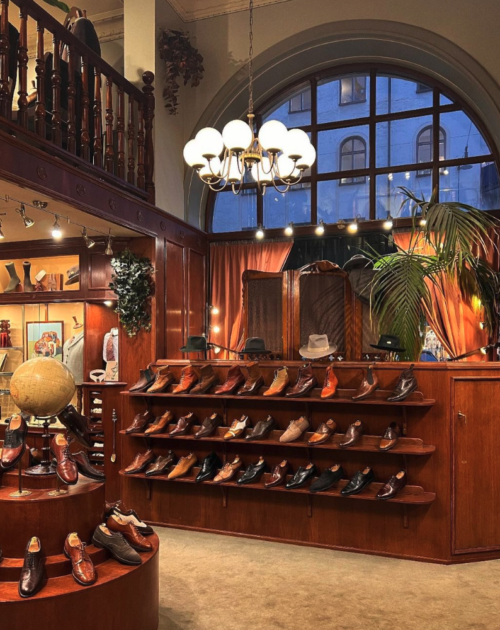
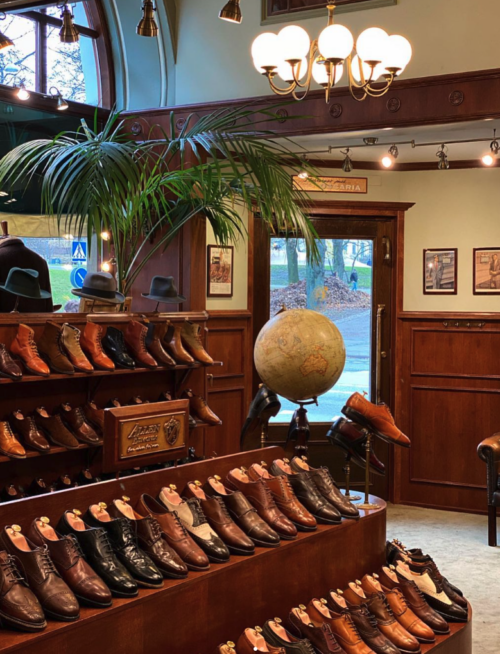
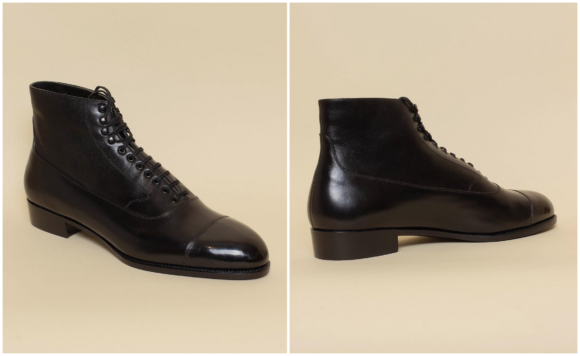
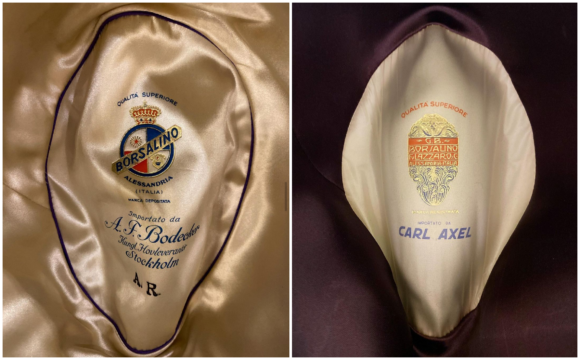
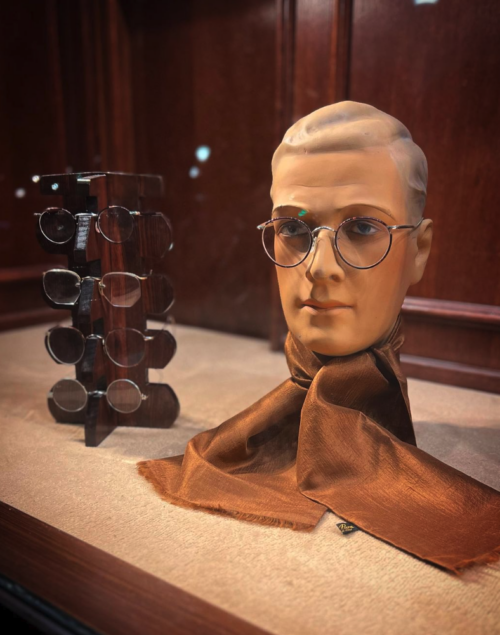
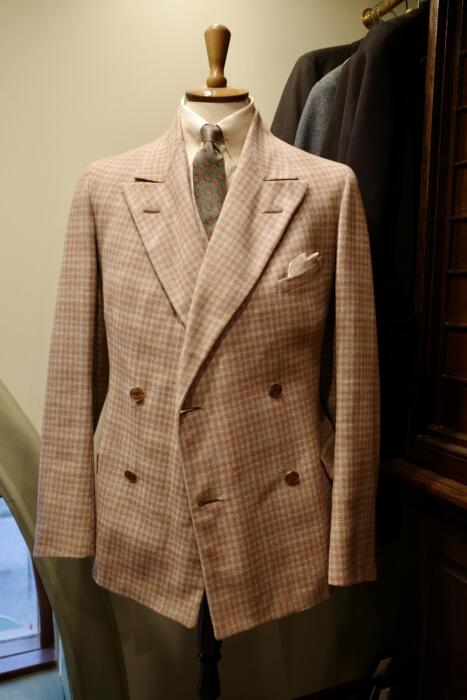
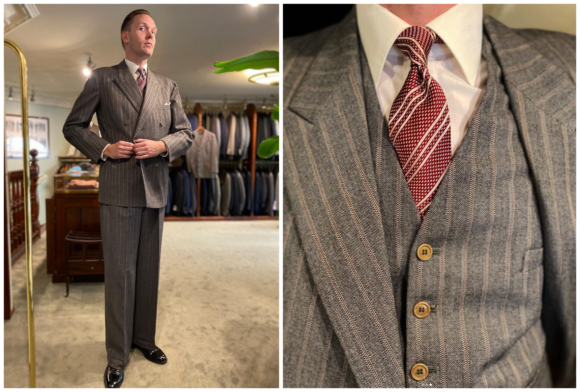
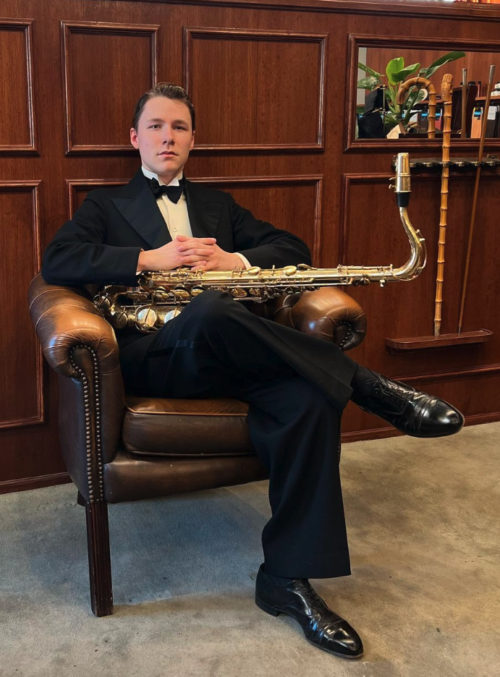
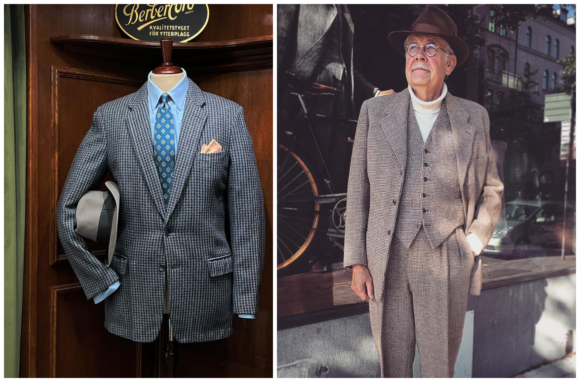
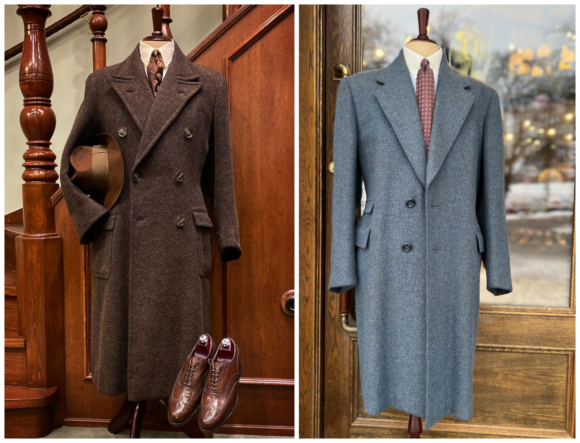
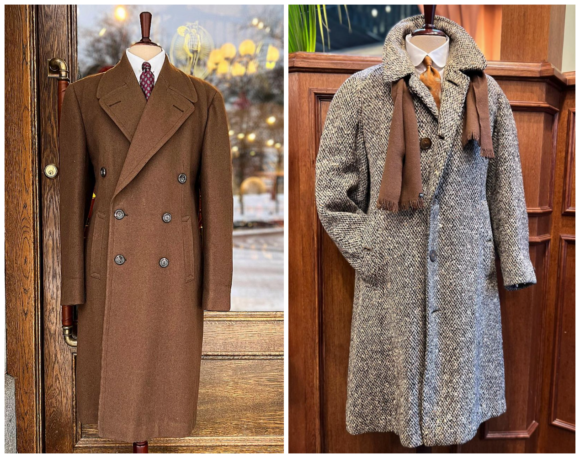
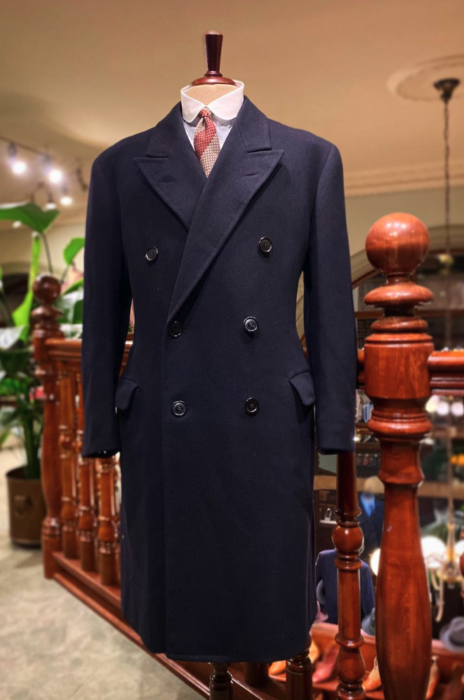
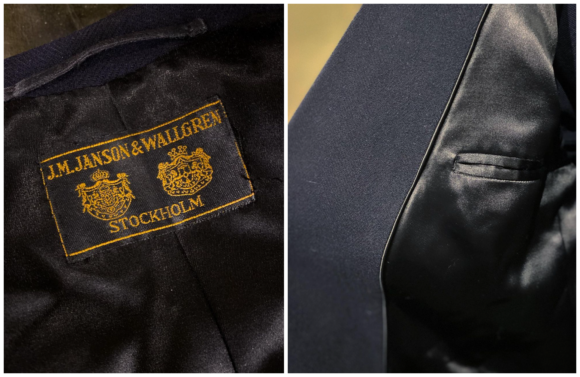


























I’m going home to Stockholm in May! Will definitely visit Marchesan! Thanks for the recommendation.
Wow, I was there in October and had no idea about this shop. Luckily it’s not that far away from Copenhagen 🙂
Great post Manish, thank you. I absolutely adore the tie worn with the two tone stripe db suit. Any idea of the maker? Also, what about prices for the coats?
Hi Philip
Thanks so much.
I’m sorry, I’m not sure on the tie but the chances are it’s Swedish made.
On the coats, I’d say they’re between £300 and £600. Still not a cheap coat but, as my friend Erik reminded me whilst I was there, you have to think of the price in terms of what something of similar quality would cost today and, in that context, it’s quite a hefty reduction.
Hilditch and Key used to have a shop on Rue de Rivoli in Paris, and many of the photos of the various shopfittings in this lovely piece remind me of how it looked.
Hi Manish
I always enjoy your articles and this one was no exception. Unfortunately I don’t think I’ll be in Stockholm in the near future. Interesting nonetheless to understand the context of the market in Stockholm and the curation together with the presentation of the store. It a shame we don’t have similar in the UK. The more general points you describe about vintage stores ring true with me, plus the strange and slightly unpleasant aroma!
Should you find any similar stores in London please do let us all know.
All the best and thanks again
Hi Stephen
Thank you so much!
Hopefully A. Marchesan’s website will be up-and-running soon so you can have a browse at least.
Yes to the aroma as well! very true!
I’m sure there are stores in London that will have similar wares – it’s just the amount of tailoring combined with the way it was presented that made A. Marchesan such a great place to shop.
Any readers with similar tips in London? 🙂
I find it particularly funny seeing the term ‘boy scout’ in an article about Stockholm, given that compared to our gender-neutral scouts but still-enduring guides, the Swedes merged the two around 50 years ago now.
All the same, what an absolute gem of a store. Having not been there in 6 years now since doing my Explorer Belt across the country, perhaps it’s soon time for me to go back.
Haha! I think I’m showing my age there, Zach. I was in the Cubs and Scouts in the 90s…I hadn’t realised they’d merged. Thanks for bringing me into the 21st century!
In fairness I only know because some Swedish scouts told me – as I said we have that rather odd middle ground in the UK these days. But yes haha, in most countries to my knowledge scouts itself has been for any/all genders for a while.
Interestingly the term seems to be a lot more common from Americans, which I suppose is less surprising given they’ve only made the move in the last couple of years. There’s actually a lot to the history – quite the rabbit hole I might be about to get stuck in.
Nice to hear you were part of it once!
Adding to my previous comment about researching this, I stand corrected (sort of): while some processes happened as early as the 60s, the Swedish girl and boy scout movements didn’t fully and officially merge until 2012.
Right, back to the beautiful vintage and vintage-inspired clothing. Where most of my disposable income goes, rather than a fair few evenings and weekends. Well, probably those too thanks to communities like these haha
Thanks very much, Zach!
It’s such a beautiful coat!
Thank you very much, Gemma 🙂
Spectacular overcoat.
I always find the economic and social history aspects of articles like this fascinating. New England was once a shoe making center, and now only a few producers remain – Alden, Rancourt, a few boutique makers for LLBean in Maine. Simon has featured Fall River in Massachusetts where some hardy souls are producing leather goods, shirts, and trousers against all odds.
Thank you, Tom.
I know Simon would love to visit New England one day to see those that remain.
It’s good to hear this about Fall River.
I worked there very briefly in the late ’90s and it had a very rough, run down town center with little else but a handful of seedy bars, rot gut Chinese places, etc. There was a nice Italian place in town, but that was it.
Interestingly, the residential areas were quite nice. Hard to square those two things.
I apologize, if I’ve wandered too far from the topic of this thread.
Anyhow, thanks Manish for holding the fort down, as they say, while… whilst 😉 Simon is away.
Hi Manish. Just a few weeks ago I purchased a 60’s Swedish Karlskrona peacoat found in a London vintage store (Blackout II) which is known for the sale and hire of period clothing. Even as I had one arm in the coat I knew it would leave with me. As has been said before stick to neutral colours, and classic silhouettes, and perhaps more importantly go with an open mind and no preconceived ideas.
It is now poised ready to be donned again just as soon as our unpredictable weather takes a turn for the worse. Roll on winter 😉
Hi Daniel
Thanks so much for sharing this. Isn’t it always the loveliest feeling when you know something is right for you so instantly.
I will have to check out Blackout II.
Don’t put it away too soon! Looks like more high winds in London tomorrow 🙂
A great store, even though at 6’4 I have trouble finding anything that fits me – folks were shorter back then, I guess.
As for coats, I think there is another great reason why they make good vintage buys: there’s less risk of an older coat looking like costume, as compared to trousers or jackets. The coat you bought doesn’t look old fashioned the way a vintage suit risks doing, and because coats are usually quite heavy (especially if made for the old Swedish winters) they tend to last extremely well. I have a vintage vicuna coat (bought at another Stockholm vintage store) from 1964, that is still holding up very well.
I fully agree with your remarks. I’ve found the same with sweaters. Yes, many “scream” old and are too much a thing of a bygone era, while others are timeless in style and if they’ve been well preserved — and have been kept far away from the stench of moth balls — then they have the benefit over most modern versions of being high quality, often hand knit and with great attention to detail.
I’m a bit over 6’4 and with an 6’8 wingspan (I really should have tried for the NBA), so I don’t even bother with vintage. But, Manish, it’s always a joy to read your pieces, your sense of humour always makes my day. Congratulations on the coat, looks beautiful!
Thanks ever so much, Robert. That means a lot to me.
The NBA’s loss is our gain!
I dunno, can you imagine what it would do for tailorings popularity if there were more NBA-players wearing good suits?
Like Jordan?
Very interesting post. I noticed so many well dressed locals on our family weekend break in Stockholm last Easter, so I am not surprised about the stock available for vintage stores.
At least half of my wardrobe is vintage, and all the better for it – as alluded to in other comments, investing circa £300 in a vintage coat usually results in quality and style that would otherwise be well out of my price range.
I wholeheartedly recommend Levkovsky Vintage in Kyiv. They’re on Instagram and well worth a look – a great collection of pieces and styles from periods and geographies across Europe.
On that note – a question for Manish: does PS have any plans to cover Ukrainian menswear at all? The last few years (for obvious reasons) has seen a real surge in interest and pride in traditional Ukrainian menswear and incorporating that into modern formal attire. It’s a look I love and it fits perfectly in the post-Covid wheres-my-tie semi-formal wardrobe
Thanks for the recommendation, Matvii.
I don’t think there’s any plans currently but never say never! Are there any Ukrainian men on Instagram (or some other platform) who wear that trad-modern style well?
I was almost skipping this article because while I’m European, I currently live in the U.S. and don’t have much opportunity to visit Sweden. I’m so glad I did not! This is an incredible store, thank you so much for the article. The overcoats looks wonderful. Now I have to figure out a way to make a vacation trip to Stockholm sound like something that would be fun for my family to do. 🙂
Thank you so much, Stephan.
Where there’s a will there’s a way 🙂
Native Stockholmian here. If you can share a bit about what the family might be interested in, I can see if I can come up with some suggestions on things they might enjoy in our fair city 🙂
What a great article Manish
I do wonder why we haven’t taken to vintage stores in the same way in the UK. I might presume it is down to the proliferation of charity shops across every, sadly shrinking, high streets.
Having been in in the retail/ consumer good s sector for a number of years now, it’s clear that the retailers who do exceptionally well CURATE. They cut and tailor ( excuse the pun) their range offer well, become distinctive and, well, don’t aim to offer everything from A to Z
I know Simon has covered some great UK vintage and pre-owned stores before, but a deeper look here would be fascinating
Thank you so much, Mark.
I agreed, that curation is often the hardest thing as it’s not just about having nice “stuff” it’s about knowing what you’re trying to say and who you’re trying to say it to.
A good suggestion for a follow-up too. Thank you 🙂
Hi Mark and Manish. Two of the best known, in London, are Hornets (for overcoats, Savile Row suits , Northampton made shoes) in Kensington and Levison’s (workwear,military) in E2. Both have a particular angle and a loyal customer base who know what to expect. I suppose current London rents preclude the opening of independents selling quality vintage or for that matter, new clothing too ?
Thanks very much, Daniel. Both good options.
Hornets does carry some similar quality stuff but the presentation makes it quite hard to browse easily so you need to spend a bit of time in amongst the rails. Perhaps this is a par of what you said about London rent – it makes it harder to have the same sort of space as A. Marchesan to display everything nicely.
I made a similar comment yesterday and if this one doesn’t make it through moderation either (assuming that it wasn’t due to a glitch), I’ll take it as confirmation that prescriptivist nitpicking is frowned upon, but “shirting”, “suiting”, and “jacketing” refer to the cloths from which shirts, suits, and jackets are made rather than the items of clothing themselves, so it might be better to say “…in-house products under development (shirts and knitwear)…” and “…vintage suits and jackets made from a heavier cloth…”.
Coats are THE bargain for used clothing. Few people wear decent coats these days. Short hiking style garments replaced them and people are prepared to get wet rather than bother with a raincoat.That means there is a plentiful supply of quality items at low prices.
I certainly agree that vintage wool coats are the definitive entry point for quality clothing. Luckily, they are incredibly unfashionable. They are definitely the best bang for your buck . Last a lifetime.
Good evening…enjoyable article..looking forward 2 what what we will b reading on wednesday and friday..cheers
Never heard of this shop, and I live one (1) subway station away… 😄